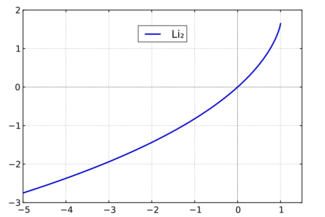Dilogarithm
In mathematics, the dilogarithm (or Spence's function), denoted as Li2(z), is a particular case of the polylogarithm. Two related special functions are referred to as Spence's function, the dilogarithm itself:
- [math]\displaystyle{ \operatorname{Li}_2(z) = -\int_0^z{\ln(1-u) \over u}\, du \text{, }z \in \Complex }[/math]
and its reflection. For |z| < 1, an infinite series also applies (the integral definition constitutes its analytical extension to the complex plane):
- [math]\displaystyle{ \operatorname{Li}_2(z) = \sum_{k=1}^\infty {z^k \over k^2}. }[/math]
Alternatively, the dilogarithm function is sometimes defined as
- [math]\displaystyle{ \int_{1}^{v} \frac{ \ln t }{ 1 -t } dt = \operatorname{Li}_2(1-v). }[/math]
In hyperbolic geometry the dilogarithm can be used to compute the volume of an ideal simplex. Specifically, a simplex whose vertices have cross ratio z has hyperbolic volume
- [math]\displaystyle{ D(z) = \operatorname{Im} \operatorname{Li}_2(z) + \arg(1-z) \log|z|. }[/math]
The function D(z) is sometimes called the Bloch-Wigner function.[1] Lobachevsky's function and Clausen's function are closely related functions.
William Spence, after whom the function was named by early writers in the field, was a Scottish mathematician working in the early nineteenth century.[2] He was at school with John Galt,[3] who later wrote a biographical essay on Spence.
Analytic structure
Using the former definition above, the dilogarithm function is analytic everywhere on the complex plane except at [math]\displaystyle{ z = 1 }[/math], where it has a logarithmic branch point. The standard choice of branch cut is along the positive real axis [math]\displaystyle{ (1, \infty) }[/math]. However, the function is continuous at the branch point and takes on the value [math]\displaystyle{ \operatorname{Li}_2(1) = \pi^2/6 }[/math].
Identities
- [math]\displaystyle{ \operatorname{Li}_2(z)+\operatorname{Li}_2(-z)=\frac{1}{2}\operatorname{Li}_2(z^2). }[/math][4]
- [math]\displaystyle{ \operatorname{Li}_2(1-z)+\operatorname{Li}_2\left(1-\frac{1}{z}\right)=-\frac{(\ln z)^2}{2}. }[/math][5]
- [math]\displaystyle{ \operatorname{Li}_2(z)+\operatorname{Li}_2(1-z)=\frac{{\pi}^2}{6}-\ln z \cdot\ln(1-z). }[/math][4]
- [math]\displaystyle{ \operatorname{Li}_2(-z)-\operatorname{Li}_2(1-z)+\frac{1}{2}\operatorname{Li}_2(1-z^2)=-\frac{{\pi}^2}{12}-\ln z \cdot \ln(z+1). }[/math][5]
- [math]\displaystyle{ \operatorname{Li}_2(z) +\operatorname{Li}_2\left(\frac{1}{z}\right) = - \frac{\pi^2}{6} - \frac{(\ln(-z))^2}{2}. }[/math][4]
Particular value identities
- [math]\displaystyle{ \operatorname{Li}_2\left(\frac{1}{3}\right)-\frac{1}{6}\operatorname{Li}_2\left(\frac{1}{9}\right)=\frac{{\pi}^2}{18}-\frac{(\ln 3)^2}{6}. }[/math][5]
- [math]\displaystyle{ \operatorname{Li}_2\left(-\frac{1}{3}\right)-\frac{1}{3}\operatorname{Li}_2\left(\frac{1}{9}\right)=-\frac{{\pi}^2}{18}+\frac{(\ln 3)^2}{6}. }[/math][5]
- [math]\displaystyle{ \operatorname{Li}_2\left(-\frac{1}{2}\right)+\frac{1}{6}\operatorname{Li}_2\left(\frac{1}{9}\right)=-\frac{{\pi}^2}{18}+\ln2\cdot \ln3-\frac{(\ln 2)^2}{2}-\frac{(\ln 3)^2}{3}. }[/math][5]
- [math]\displaystyle{ \operatorname{Li}_2\left(\frac{1}{4}\right)+\frac{1}{3}\operatorname{Li}_2\left(\frac{1}{9}\right)=\frac{{\pi}^2}{18}+2\ln2\cdot\ln3-2(\ln 2)^2-\frac{2}{3}(\ln 3)^2. }[/math] [5]
- [math]\displaystyle{ \operatorname{Li}_2\left(-\frac{1}{8}\right)+\operatorname{Li}_2\left(\frac{1}{9}\right)=-\frac{1}{2}\left(\ln{\frac{9}{8}}\right)^2. }[/math][5]
- [math]\displaystyle{ 36\operatorname{Li}_2\left(\frac{1}{2}\right)-36\operatorname{Li}_2\left(\frac{1}{4}\right)-12\operatorname{Li}_2\left(\frac{1}{8}\right)+6\operatorname{Li}_2\left(\frac{1}{64}\right)={\pi}^2. }[/math]
Special values
- [math]\displaystyle{ \operatorname{Li}_2(-1)=-\frac{{\pi}^2}{12}. }[/math]
- [math]\displaystyle{ \operatorname{Li}_2(0)=0. }[/math]
- [math]\displaystyle{ \operatorname{Li}_2\left(\frac{1}{2}\right)=\frac{{\pi}^2}{12}-\frac{(\ln 2)^2}{2}. }[/math]
- [math]\displaystyle{ \operatorname{Li}_2(1) = \zeta(2) = \frac{{\pi}^2}{6}, }[/math] where [math]\displaystyle{ \zeta(s) }[/math] is the Riemann zeta function.
- [math]\displaystyle{ \operatorname{Li}_2(2)=\frac{{\pi}^2}{4}-i\pi\ln2. }[/math]
- [math]\displaystyle{ \begin{align} \operatorname{Li}_2\left(-\frac{\sqrt5-1}{2}\right) &=-\frac{{\pi}^2}{15}+\frac{1}{2}\left(\ln\frac{\sqrt5+1}{2}\right)^2 \\ &=-\frac{{\pi}^2}{15}+\frac{1}{2}\operatorname{arcsch}^2 2. \end{align} }[/math]
- [math]\displaystyle{ \begin{align} \operatorname{Li}_2\left(-\frac{\sqrt5+1}{2}\right) &=-\frac{{\pi}^2}{10}-\ln^2 \frac{\sqrt5+1}{2} \\ &=-\frac{{\pi}^2}{10}-\operatorname{arcsch}^2 2. \end{align} }[/math]
- [math]\displaystyle{ \begin{align} \operatorname{Li}_2\left(\frac{3-\sqrt5}{2}\right) &=\frac{{\pi}^2}{15}-\ln^2 \frac{\sqrt5+1}{2} \\ &=\frac{{\pi}^2}{15}-\operatorname{arcsch}^2 2. \end{align} }[/math]
- [math]\displaystyle{ \begin{align} \operatorname{Li}_2\left(\frac{\sqrt5-1}{2}\right) &=\frac{{\pi}^2}{10}-\ln^2 \frac{\sqrt5+1}{2} \\ &=\frac{{\pi}^2}{10}-\operatorname{arcsch}^2 2. \end{align} }[/math]
In particle physics
Spence's Function is commonly encountered in particle physics while calculating radiative corrections. In this context, the function is often defined with an absolute value inside the logarithm:
- [math]\displaystyle{ \operatorname{\Phi}(x) = -\int_0^x \frac{\ln|1-u|}{u} \, du = \begin{cases} \operatorname{Li}_2(x), & x \leq 1; \\ \frac{\pi^2}{3} - \frac{1}{2}(\ln x)^2 - \operatorname{Li}_2(\frac{1}{x}), & x \gt 1. \end{cases} }[/math]
See also
Notes
- ↑ Zagier p. 10
- ↑ "William Spence - Biography". https://mathshistory.st-andrews.ac.uk/Biographies/Spence/.
- ↑ "Biography – GALT, JOHN – Volume VII (1836-1850) – Dictionary of Canadian Biography". http://www.biographi.ca/009004-119.01-e.php?BioId=37522.
- ↑ 4.0 4.1 4.2 Zagier
- ↑ 5.0 5.1 5.2 5.3 5.4 5.5 5.6 Weisstein, Eric W.. "Dilogarithm". http://mathworld.wolfram.com/Dilogarithm.html.
References
- Lewin, L. (1958). Dilogarithms and associated functions. Foreword by J. C. P. Miller. London: Macdonald.
- Morris, Robert (1979). "The dilogarithm function of a real argument". Math. Comp. 33 (146): 778–787. doi:10.1090/S0025-5718-1979-0521291-X.
- Loxton, J. H. (1984). "Special values of the dilogarithm". Acta Arith. 18 (2): 155–166. doi:10.4064/aa-43-2-155-166. http://pldml.icm.edu.pl/mathbwn/element/bwmeta1.element.bwnjournal-article-aav43i2p155bwm?q=bwmeta1.element.bwnjournal-number-aa-1983-1984-43-2&qt=CHILDREN-STATELESS.
- Kirillov, Anatol N. (1995). "Dilogarithm identities". Progress of Theoretical Physics Supplement 118: 61–142. doi:10.1143/PTPS.118.61. Bibcode: 1995PThPS.118...61K.
- Osacar, Carlos; Palacian, Jesus; Palacios, Manuel (1995). "Numerical evaluation of the dilogarithm of complex argument". Celest. Mech. Dyn. Astron. 62 (1): 93–98. doi:10.1007/BF00692071. Bibcode: 1995CeMDA..62...93O.
- Zagier, Don (2007). "The Dilogarithm Function". Frontiers in Number Theory, Physics, and Geometry II. pp. 3–65. doi:10.1007/978-3-540-30308-4_1. ISBN 978-3-540-30308-4. http://maths.dur.ac.uk/~dma0hg/dilog.pdf.
Further reading
- Bloch, Spencer J. (2000). Higher regulators, algebraic K-theory, and zeta functions of elliptic curves. CRM Monograph Series. 11. Providence, RI: American Mathematical Society. ISBN 0-8218-2114-8.
External links
- NIST Digital Library of Mathematical Functions: Dilogarithm
- Weisstein, Eric W.. "Dilogarithm". http://mathworld.wolfram.com/Dilogarithm.html.
 |


